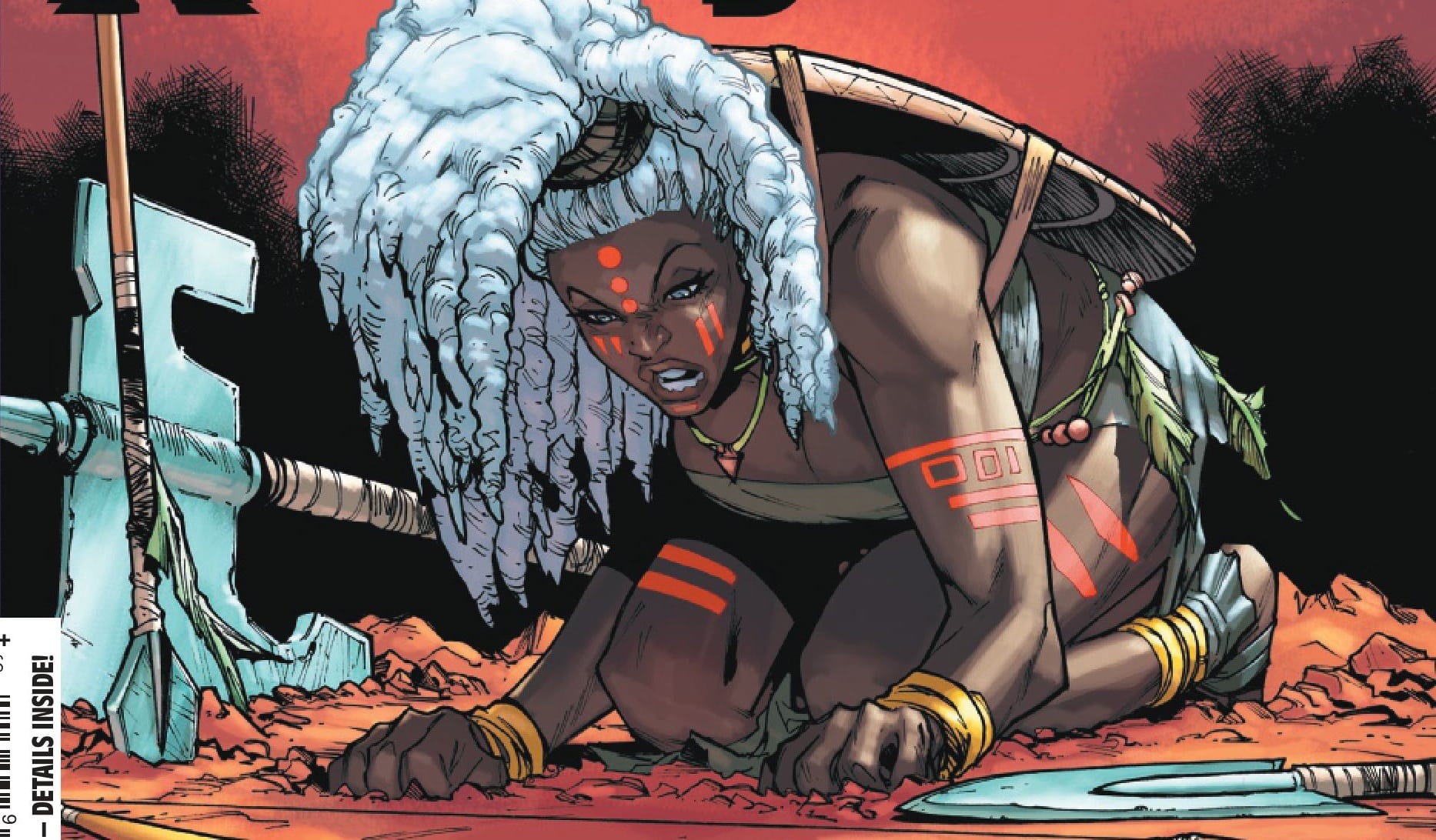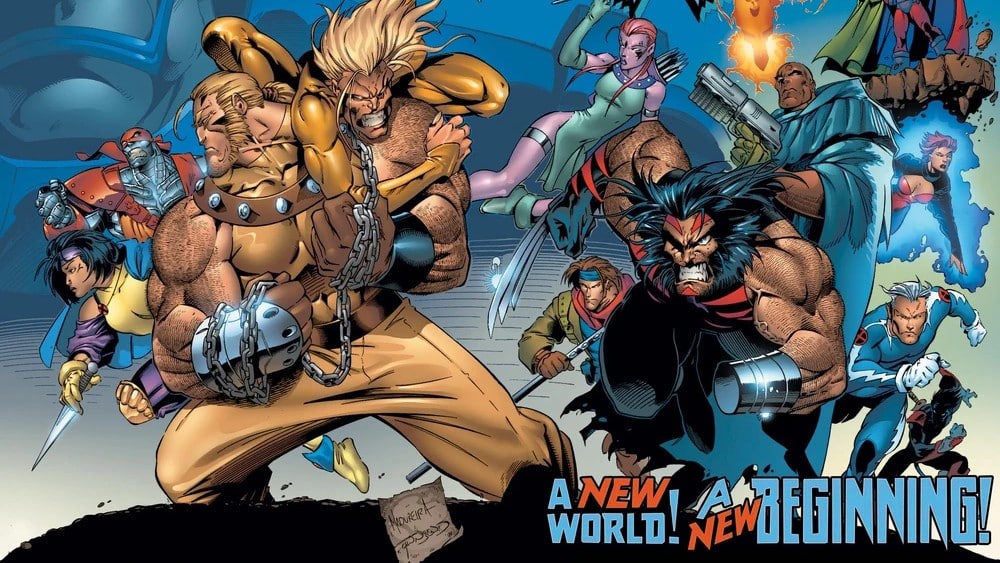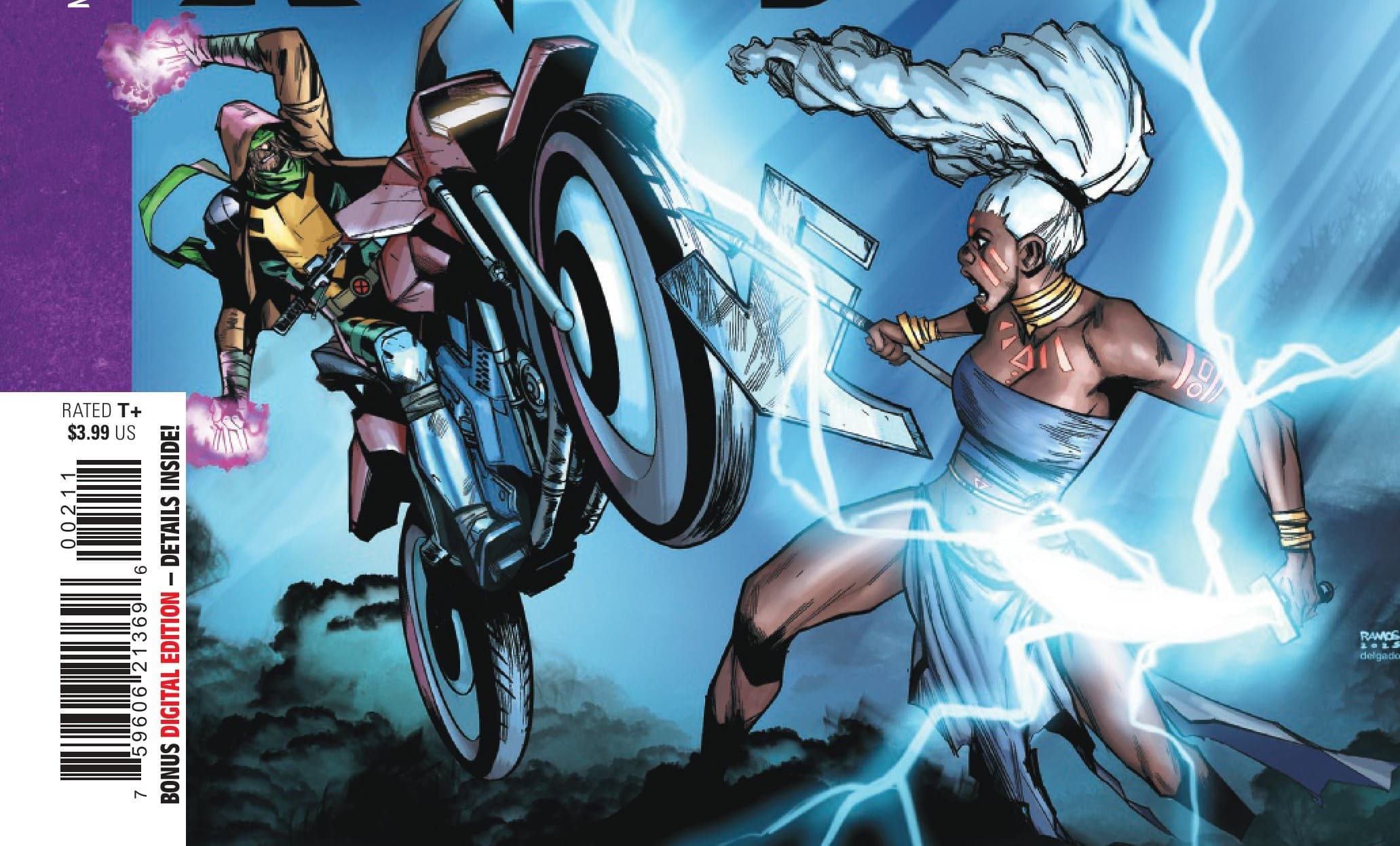The brutal conclusion to the “Red Wave” storyline is here. The Uncanny X-Men face an unstoppable force of evil and death who reveals a shocking secret, but they may not survive long enough to face it. Will the next generation of young mutants stand by Rogue and her team or join the other side? Uncanny X-Men #5 is written by Gail Simone, drawn by David Marquez, colored by Matthew Wilson and lettered by Clayton Cowles.
Jake Murray: Welcome to another edition of ComicsXF ToX Uncanny X-Men. Ah cain’t … sorry … I cannot wait to dig into the action from the last issue of this series’ first arc, but first of all, hello, Anna. How’s it going?
Anna Peppard: My wrist isn’t broken and I’m not stuck reading sonnets with a speech therapist to try to cure my Canadian accent, so I guess I’m mostly fine … though like a lot of us, less fine than before Nov. 5. Anyway, the sun still rises and mutants are still uncanny and I’m doing my best to focus on that.
Jake: This issue is a neat microcosm of this initial arc for me: overall enjoyable, but there are some … curiosities, writing decisions that I’ve found quite distracting and detracting through these first five issues. The Charles Xavier girlfriend-in-a-retcon phenomenon we’ve discussed at length in previous reviews is definitely one, its disconnectedness from continuity is another, and there are a couple more that rear their head in this issue that we’ll get to later.
Now that we’ve fired up our horses and rounded our vowels, let’s get to the issue.
Deus Ex Mutant

Jake: Plot summary time. Let’s keep this snappy. The issue opens on a rather bashful Rogue receiving elocution lessons, but it’s not long before reality begins to bleed through as the page turn reveals Rogue lying prostrate, bent and broken at the hands of Sarah Gaunt. As Sarah begins to torment and torture her, our hero is pulled onto the astral plan by Harvey X, the child she witnessed dying in the first issue. Harvey reveals his seemingly limitless power set, including telepathy, a healing factor and precognition. He reveals it was he who led The Outliers to the X-Men’s door to protect them from Sarah. It also turns out that, by touching her hand in the hospital in issue #1, he also lent Rogue his powers. She is then able to heal her broken wrist, get into Sarah’s head and wreck her MIND, BODY AND SOUL.
Meanwhile, the other X-Men and The Outliers prepare to battle Sarah’s assembled forces as they descend on Haven House in Louisiana. Mutants young and old hold back the zombie horde admirably, concluding in a beautiful moment of synchronicity as Gambit uses the Eye of Agamotto he stole in issue #1 to destroy Sarah’s army as his wife dispatches their leader.
For what it’s worth, the story also seems to absolve Xavier of any wrongdoing. It turns out Sarah wasn’t pregnant with his child but wanted to trick him into thinking she was? She then got pregnant a few months later? I have to admit, I found this a bit confusing.
Anna: It’s very confusing. First of all, I’m confused about why we spent so very many valuable pages with Charles Xavier in this story arc, only to have him be completely unimportant except as a misdirect. Granted, this is a subjective gripe; you could argue we needed to spend that long with Charles to make the misdirect land. But for me, it doesn’t land, partly because of the additional confusion around the timeline, where Sarah apparently tried to convince Charles she was pregnant a full year before she actually was.
It seems like it would make more sense for her to try to convince Charles the baby was his after she became pregnant? If only because this would help explain why he’s so central to her villain origin story. As presented, Charles is just some guy Sarah briefly dated before having a baby with a totally separate person in a presumably different country a year later. Short of “she’s just crazy like that” (which doesn’t help subvert the monstrous-mother trope we’ve discussed in past reviews), I can’t quite understand why Sarah is so focused on Charles. Maybe there will be more to it later? Maybe Charles is involved in the development of her powers, in some way? It does seem, in the flashbacks, that she intentionally seeks him out for some undisclosed reason. But it feels, right now, like we’ve wrapped up Sarah’s story.
I do hope we revisit this story at some point, since I continue to have a lot of additional questions about what Sarah’s powers are and how she got them. I also have a ton of questions about her “followers.” But we’ll dig into that in a bit.
Jake: The same applies to our new mutant Swiss army knife Harvey, who at least got a classic fade-into-the-ether exit to cap off his big hero turn. If Charles’ exes are a staple of X-history, unearthing mutants with the power to control the world and everyone in it is another franchise classic. The way Simone and Marquez revealed Harvey X to be the deus ex machina mutant who saves the day was so ridiculous I sort of loved it. Breaking his and Rogue’s conversation up into three scenes, in which a new power is revealed each time via this ludicrous escalation of reveals, is funny to me because it’s very knowing.
The line “Yes. Okay. I’ve been keeping another secret. Sorry.” prefacing the reveal of Harvey’s healing power after the previous two scenes had already revealed telepathy (via a classic “fade to white” astral plane moment) and precognition (via a tantalizing array of future projections) reminds me of an improv troupe who are a little bit high off their own supply. Marquez’s construction of these panels is absolutely brilliant. He nails the punchline every time, whether by framing Harvey X as a literal Jesus figure standing among some absurd looking future timelines, or ironically downplaying his vast power by drawing his face with a cartoonish bashfulness, or giving him a smug Charles Xavier grin as he reveals his final secret. It’s not played off really seriously, which is a relief because it’s almost impossible to take it that way.
Mutant finishing school

Jake: We’ve made quite a few jokes about Rogue’s dialect throughout our coverage of this series so far. Yes, the phrasing was a little tortured and ridiculous; yes, it was way over the top, even compared to famed phonetic accent enthusiast Chris Claremont’s conception of the character, but after a few issues I’d begun to accept Simone’s choice to celebrate this aspect of Rogue’s identity. What I never expected, and honestly what I have a hard time accepting, is the decision to not just draw attention to it explicitly but to use it to represent Rogue’s insecurity about her leadership ability.
As much as I enjoy any character’s internality being explored in the way Simone does here, Rogue letting something like her upbringing be a barrier to her role as an X-man doesn’t ring true to me. Throughout her history, Rogue has shaken off perceived barriers to connecting with others, whether that be her upbringing in the Brotherhood of Evil Mutants, her lack of worldliness (see the poignant scene with Gateway in Uncanny X-Men #230) or steaming headfirst into creating the most batshit team of X-Men imaginable in Mike Carey and Chris Bachalo’s X-Men.
And that’s not to say that because she’s not been that introspective, or particularly insecure about anything that’s not her powers, that she can never be. What this series and this era of X-Men comics should do that it hasn’t done, though, is acknowledge the history it’s diverging from and why it’s different. I like the instinct to explore Rogue’s class, but the way it’s presented in this run is the dialectic equivalent of a strawman argument. The decision to make her dialect broader and more stereotypical than it’s ever been before, to use her class as a reason for her self-doubt, both doesn’t chime with her character history, nor is it something that’s really been seeded in this run before this issue. The series sometimes feels like it exists in a vacuum, which is something I struggle a bit to get past.
Anna: You nailed my main issue with this elocution lessons subplot, which is that it was introduced in issue #5 of a five-issue story arc. This makes it feel less like a structuring theme of Rogue’s journey in this series and more like an unearned bid for depth in a story that’s sometimes struggled to achieve much depth beyond the pretty universally accepted fact that kids dying is bad (unless they’re been transformed into monsters against their will, but we’ll get to that).
While I love that Simone is centering Rogue’s perspective, and while I’ve enjoyed some individual moments of her internal monologues, I still wish I had a more grounded sense of Rogue’s specific perspective amid the events that supposedly led her to this place. What is her specific reaction to the (sort of) fall of Krakoa? Why has she become somewhat reluctant to be a leader? Where are these new insecurities coming from? Obviously, Simone doesn’t have to info dump answers to all these questions in a single issue or story arc. But I can’t quit contemplating the strange fact that while I’ve been given lots of access to Rogue’s thoughts in this series, and while her individuality does shine through, I don’t have a strong sense of how her history informs her perspective.
I have a similar issue, but more so, with Jubilee’s brief foray into monologuing in this issue. There’s nothing “wrong” with Jubilee’s internal monologue; it’s composed of facts about her general deal. But it’s nothing more than that. She basically states her origin story, saying (paraphrasing), “I’m a mall kid turned semi-reluctant superhero and my bestie is Logan.” Except this is her origin story circa the mid-’90s. We’re not offered anything specific about her history since then, which I guess is helpful for readers who might only know Jubes from X-Men: The Animated Series and X-Men ’97, but a bit empty for those of us who’ve followed her beyond that.
Battle of the sainted mother

Anna: So remember how Uncanny X-Men #1 ended with a young girl, human name Rosa, mutant name Fawn, with antlers and deer legs who was being pursued through the woods by creepy dudes with lightsabers and the bigoted words and sharp claws of the villain subsequently revealed as Sarah Gaunt? Last issue, we learned she’d been transformed into some kind of gothic and I guess evil version of herself by Sarah’s still-mysterious powers. Which raises the question, is Sarah’s entire army, which Gambit refers to as a “cult,” composed of transformed mutants?
With regard to Fawn, specifically, we don’t know whether she’s still alive in some capacity, or if her body is just a zombie husk controlled by Sarah. Gambit does tell us that some members of Sarah’s army apparently got less monstrous, or at least less determinedly evil, somewhere off panel after Rogue took down Sarah. After which, this new X-Men team that’s supposedly dedicated to starting a new tradition of training and protecting mutant youth just lets them wander off into the forest. Except, I guess, for the many members of the army Logan killed. Maybe their bodies just conveniently dissolved like so many video game baddies and undead Hand ninjas before them?
I know it’s just a show and I should really just relax, but given that the first issue of this series wrapped with Fawn shouting “Noooooo!” after a series of scenes depicting her as excessively scared and vulnerable, it feels like I’m supposed to care about her fate. Except that none of the X-Men seem to care at all? Granted, it’s not the first time the X-Men have said they care about keeping teens safe only to recklessly endanger them for the sake of letting talented artists draw cool kills. But I have to admit I expected something better from a book that’s done a lot of posturing about the importance of mutant family. Why do some kids get saved and soothed and obsessed over while others get stabbed?
Speaking of stabbing, while I’m trying to appreciate Simone’s attempt to address the still-very-weird fact that Kurt decided to gleefully murder people during the fall of Krakoa, the moment didn’t quite land for me. Basically, Ransom observes that Kurt used to have a sword, to which Kurt replies, “I’m not a killer, Ransom. I thought I was. I was wrong.” But Kurt didn’t use his sword to kill people during the fall of Krakoa (his one on-panel kill involved teleporting a guy into space), and he’s used swords for many years during eras in which he definitely never killed anyone (swords were, for instance, a big feature of Dave Cockrum’s defiantly lighthearted 1985 Nightcrawler miniseries). There was also that whole “Hope Sword” thing, but if this era wants to forget that, that’s honestly fine with me. I fully acknowledge I’m getting lost in the weeds here, but this series has been accumulating character moments that just feel slightly “off,” and for me, this was one of them.
Jake: A lot of the issues you’ve highlighted all tie into one of the overall frustrations I have with this run, which is prioritization of characters and plot lines. The greatest opportunity Simone and Marquez hold in their hands to create a connection between the audience and their series is one they themselves have created: The Outliers. Brief origin stories, a training montage and some cool moves aside, they’ve been shoved into the background while a Charles Xavier moral outrage fakeout, Sarah Gaunt’s confusing motivations and Rogue doing My Fair Lady take center stage.
It’s not a case of selective hearing that these will be the elements from the first arc that I remember. It’s simply what has received the most page time. However, this series still has an opportunity to be interesting. With The Outliers on the cover of issue #6, and a promise to return to the “Endling” mystery that was teased in issue #1 (remember that?), it could happen soon.
Anna: I hope so. I want to trust that this series knows where it’s heading. Simone certainly has the experience to prove she knows how to write long-running serials, and Harvey X’s return this month did provide a nice bookend to where we began. But a lingering sense of placelessness keeps on keeping me at a distance. Maybe a renewed focus on The Outliers will clarify the book’s mission statement.
Until then, take care of each other out there. Fighting evil is important. But for those of us who don’t have mutant healing factors, so is eating and sleeping and hydrating and cuddling on the couch with your sweeties and your pets to make sure you’re strong enough to fight it.
X-Traneous Thoughts
- A highlight of the climactic battle was Marquez drawing another spectacular transformation for Calico and Ember, this time into a glowy girl-and-her-horse version of the Juggernaut.
- No jokes about Rogue’s sexiness this week, although Sarah Gaunt does say “Wake Up. Or Mummy Spank” to her, so you tell me which is worse?
- The word Gambit uses to refer to the Eye of Agamotto, “fifolet” is a word from Cajun folklore referring to a bright light in the swamp said to misdirect or disorient those who try to follow it, which is a hell of a reference.
- Similarly, when Jitter says “this is so damn rabak!” she is using Malay slang for “out of control.” Impeccable research from Gail all around.
Buy Uncanny X-Men #5 here. (Disclaimer: As an Amazon Associate, ComicsXF may earn from qualifying purchases.)







